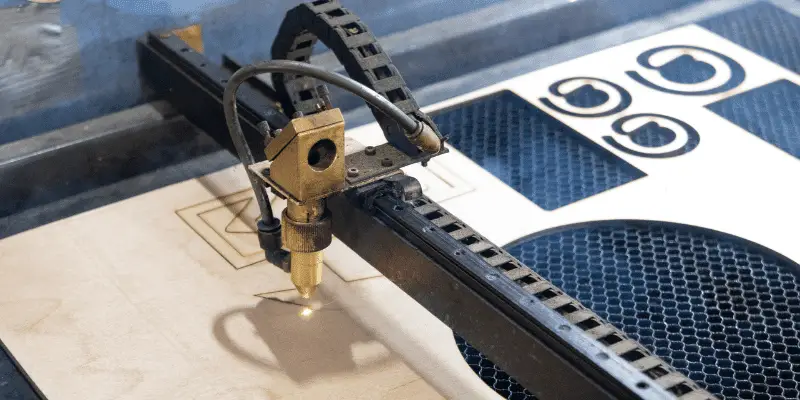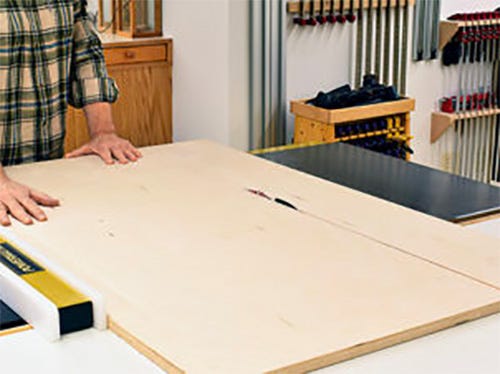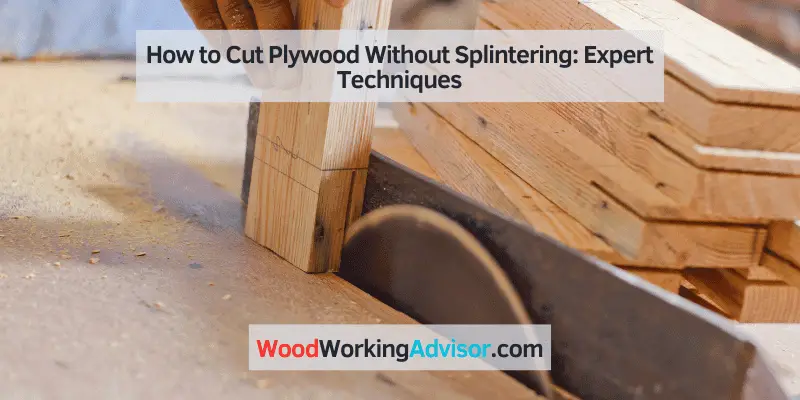To cut plywood without splintering, there are a few methods you can use. One method is to apply masking tape to the cut line and cut through the tape, which provides extra support to the wood fibers.
Another method is to use a fine-toothed blade or a negative rake blade on your saw. Additionally, scoring the cut line with a utility knife before making the full cut can help prevent splintering.
Understanding The Importance Of Clean Plywood Cuts
When cutting plywood, it is important to understand the significance of clean cuts and how to prevent splintering. By using techniques such as pre-scoring the cut, using a negative rake blade, and setting up the saw properly, you can minimize splintering and achieve precise results.
When it comes to woodworking, achieving clean and smooth cuts in plywood is essential for the overall quality and appearance of your projects. Not only do clean cuts contribute to a visually pleasing finish, but they also play a vital role in maintaining the strength and integrity of the plywood.
Why splintering can ruin your woodworking projects:
- Splintering can greatly affect the aesthetics of your project. It can create rough edges and unsightly tearouts, diminishing the overall beauty of your finished piece.
- Splintered edges can also compromise the structural integrity of the plywood, reducing its strength and durability.
- Moreover, working with splintered plywood can be challenging when it comes to joining pieces together, as it can affect the accuracy and fit of your joints.
The impact of splintering on the appearance and strength of plywood:
- Splintering can lead to jagged and uneven edges, making it difficult to achieve a professional-looking finish.
- It can also make it harder to apply a smooth and even coat of paint or stain, as the rough surface of the plywood can trap and absorb the finishing product unevenly.
- In terms of strength, splintered wood fibers can weaken the overall structure of the plywood, making it more susceptible to breakage or warping.
The value of clean and smooth cuts in woodworking:
- Clean cuts in plywood not only improve the overall appearance of your woodworking projects but also make them more visually appealing and professional-looking.
- Smooth edges facilitate easier assembly and provide a seamless fit when joining pieces together.
- By minimizing splintering, you can increase the strength and durability of your plywood, ensuring that your projects stand the test of time.
Understanding the importance of clean and smooth cuts in plywood is crucial for any woodworking enthusiast or professional. By minimizing splintering, you can achieve visually pleasing results, enhance the strength and durability of your projects, and ultimately take your woodworking skills to the next level.
Choosing The Right Tools And Blades
To cut plywood without splintering, it’s important to choose the right tools and blades. Pre-scoring the cut, using a negative rake blade, and setting up the saw properly can help prevent splintering and ensure clean cuts. Applying masking tape to the cut can also provide extra support to the wood fibers and reduce tear-out.
Don’t have to be a professional carpenter to cut plywood without splintering. With the right tools and blades, you can achieve clean cuts and avoid those annoying splinters. In this section, we will explore how to choose the appropriate saw for cutting plywood, understand the different types of saw blades available, and discover the benefits of using specialty blades for splinter-free cuts.
Selecting The Appropriate Saw For Cutting Plywood:
- Circular Saw: A versatile tool that allows for easy maneuverability and precise cuts. It is ideal for cutting large pieces of plywood.
- Jigsaw: Perfect for cutting curved or intricate designs on plywood.
- Table Saw: Provides stability and accurate straight cuts, making it suitable for larger projects.
Understanding The Different Types Of Saw Blades Available:
- Plywood Blades: These blades have more teeth per inch and are specifically designed for cutting plywood. They have a high tooth count and a low tooth angle to reduce splintering.
- Fine-Toothed Blades: These blades are ideal for clean and smooth cuts on plywood. They have a high tooth count, providing precision and minimizing splintering.
- Carbide-Tipped Blades: These blades are highly durable and can handle cutting through different types of plywood without splintering.
Exploring The Benefits Of Using Specialty Blades For Splinter-Free Cuts:
- Reduced Splintering: Specialty blades are designed to minimize splintering, resulting in clean cuts that don’t require further sanding or refinishing.
- Precise Cuts: Using the appropriate blade ensures accurate and precise cuts, which is crucial for woodworking and other projects.
- Time and Effort Savings: Specialty blades help you achieve splinter-free cuts, saving you time and effort in finishing and sanding the cut edges.
By choosing the right saw and blade for cutting plywood, you can achieve clean and splinter-free cuts. Whether you’re working on a small DIY project or a large woodworking endeavor, following these guidelines will help you cut plywood without splintering and achieve professional-looking results.

Techniques For Splinter-Free Plywood Cuts
Learn how to cut plywood without splintering by following these simple techniques. Pre-score the cut, use a negative rake blade, and set up the saw properly to reduce tear-out and achieve clean cuts. Prevent splintering during sawing and get great results with these expert tips.
When it comes to cutting plywood, splintering can be a common issue that frustrates many DIY enthusiasts and professionals alike. However, with the right techniques and tools, you can achieve clean and splinter-free cuts every time. Here are some effective techniques to help you cut plywood without splintering:
Pre-Scoring The Plywood For Cleaner Cuts:
- Before making your final cut, use a utility knife or a scoring tool to create a shallow cut along the intended cutting line. This pre-scoring technique helps to weaken the wood fibers and prevents tear-out during the cutting process.
Using Masking Tape To Prevent Splintering:
- Applying masking tape along the cutting line can significantly reduce splintering by providing support to the wood fibers. Make sure to firmly press the tape onto the plywood before cutting.
Optimizing Cutting Techniques With A Circular Saw:
- Choose a saw blade with a high tooth count to minimize splintering when using a circular saw. Set the blade to a depth that just barely exceeds the thickness of the plywood. Start by making a scoring cut, then gradually increase the depth for cleaner cuts.
Strategies For Cutting Plywood On A Table Saw:
- Use a combination blade with a high tooth count and a low hook angle to minimize splintering when cutting plywood on a table saw. Make sure the blade is sharp and clean for optimal results. Additionally, using a zero-clearance insert can help prevent tear-out.
Implementing A Track Saw For Precise Cuts:
- A track saw is specifically designed for clean and splinter-free cuts. Its guide rail system ensures accurate and straight cuts, minimizing the risk of tear-out. Simply align the track with your cutting line and let the saw do the rest.
Utilizing A Table Saw Sled For Better Control During Cuts:
- A table saw sled provides excellent stability and control when cutting plywood. By sliding the sled along the table saw’s fence, you can achieve accurate and splinter-free cuts. Make sure the sled is securely fastened and the blade is properly aligned with the cutting line.
By incorporating these techniques into your plywood cutting process, you can greatly reduce the risk of splintering and achieve professional-quality results. Remember to choose the right tools, keep your blades sharp, and always practice safe cutting techniques to ensure the best possible outcome.
Happy cutting!
Additional Tips And Tricks
Learn how to cut plywood without splintering with these additional tips and tricks. Discover useful techniques like pre-scoring the cut, using a negative rake blade, and setting up the saw properly to prevent splintering and achieve clean cuts. Say goodbye to rough edges and create flawless plywood cuts.
When it comes to cutting plywood without splintering, there are a few additional tips and tricks you can use to ensure clean and smooth cuts. These techniques can help minimize tearout and protect the integrity of the plywood. Here are some strategies you can employ:
- Raising the blade high for reduced tearout: One effective way to reduce tearout and splintering is to raise the blade of your saw to its highest setting. This allows the teeth of the blade to make a shallow cut, minimizing the chances of tearout. Keep in mind that this technique works best with a fine-toothed blade.
- Incorporating a splinter guard for added protection: Another useful tool for preventing splintering while cutting plywood is a splinter guard. This is a specialized attachment that can be added to your saw to provide an extra layer of protection. The splinter guard is designed to prevent the wood fibers from splintering or tearing as the blade passes through the plywood.
- Setting up the saw properly for optimal cutting results: Proper setup of your saw is crucial for achieving clean cuts without splintering. Make sure the blade is aligned and tightened securely. Check that the table or cutting surface is stable and level. Taking the time to set up your saw correctly can make a big difference in preventing splintering during cutting.
- Maintaining sharp blades for cleaner plywood cuts: Dull blades can cause tearout and splintering, so it’s important to keep your saw blades sharp. Regularly inspect your blades for any signs of damage or dullness, and sharpen or replace them as needed. Using sharp blades will ensure cleaner and smoother cuts through the plywood.
- Step-by-step guide to preventing splintering during sawing: To help you further, here’s a step-by-step guide on how to prevent splintering when cutting plywood:
- Measure and mark your cut line accurately on the plywood.
- Use masking tape along the cut line to provide additional support and prevent tearout.
- Set the blade height on your saw to the highest setting.
- Place the plywood on a stable surface and secure it if necessary.
- Start the saw and position the blade just outside the cut line.
- Slowly guide the saw along the cut line, applying even pressure.
- Let the saw do the work, avoiding any abrupt movements.
- Take your time and make sure to follow the cut line precisely.
- If needed, use a splinter guard or a zero-clearance insert for added protection.
- After completing the cut, carefully remove any remaining tape or masking material.
By following these additional tips and tricks and implementing the step-by-step guide, you can significantly reduce splintering and achieve cleaner and smoother cuts when working with plywood. Remember to take your time, use the appropriate tools, and maintain sharp blades for optimal results.
Happy cutting!

Credit: www.rockler.com
Frequently Asked Questions Of How To Cut Plywood Without Splintering
How Do You Keep Plywood From Splintering When You Cut It?
To prevent plywood from splintering when cutting it, you can follow these tips:
1. Use a sharp saw blade.
2. Apply masking tape along the cutting line.
3. Support the plywood with a sacrificial backing board.
4. Cut slowly and steadily, without rushing.
By following these steps, you can achieve clean and splinter-free cuts in plywood.
How Do You Cleanly Cut Plywood?
To cleanly cut plywood, follow these steps:
1. Use a sharp circular saw blade.
2. Pre-score the cut with a utility knife.
3. Apply masking tape along the cut line for added support.
4. Use a straight edge or guide to ensure straight cuts.
By following these guidelines, you can achieve clean cuts without splintering the plywood.
What Is The Best Thing To Cut Plywood On?
The best thing to cut plywood on is a circular saw. Using a guide or jig can help make long, straight cuts.
How Do You Keep Wood From Splintering When Cutting?
To keep wood from splintering when cutting, follow these tips:
1. Use masking tape on the cut line for extra support.
2. Score the wood with a utility knife before cutting.
3. Use a saw blade with a negative rake angle.
4. Consider using a track saw or a table saw with a splinter guard. Remember to follow these guidelines to ensure clean cuts without splintering.
Conclusion
Cutting plywood without splintering can be achieved by following a few simple techniques. Using the right tools, such as a sharp saw blade or a negative rake blade, can greatly minimize splintering. Additionally, pre-scoring the cut or using a splinter guard can also help prevent splintering.
Another useful tip is to apply masking tape on the cut line, as this provides extra support to the wood fibers being cut. Furthermore, raising the blade high and using a table saw sled can ensure clean cuts. When cutting plywood with a circular saw, using a guide or a jig can help maintain straight cuts.
By implementing these strategies, you can achieve smooth and splinter-free cuts on plywood. Remember to take your time, be careful, and prioritize safety throughout the process. Happy cutting!



3 thoughts on “How to Cut Plywood Without Splintering: Expert Techniques”